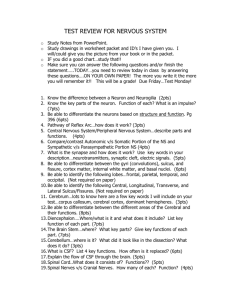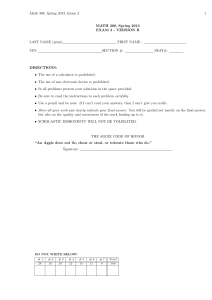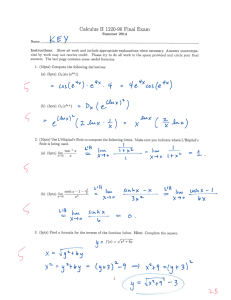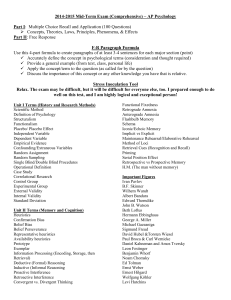Document 17974406
advertisement
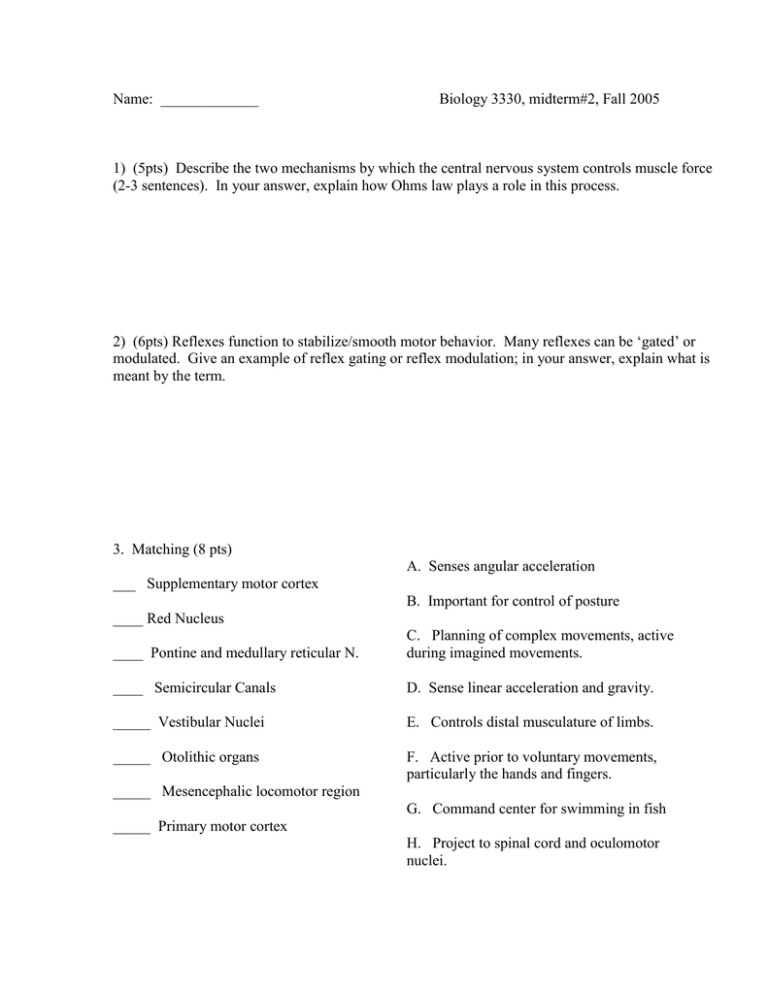
Name: _____________ Biology 3330, midterm#2, Fall 2005 1) (5pts) Describe the two mechanisms by which the central nervous system controls muscle force (2-3 sentences). In your answer, explain how Ohms law plays a role in this process. 2) (6pts) Reflexes function to stabilize/smooth motor behavior. Many reflexes can be ‘gated’ or modulated. Give an example of reflex gating or reflex modulation; in your answer, explain what is meant by the term. 3. Matching (8 pts) A. Senses angular acceleration ___ Supplementary motor cortex B. Important for control of posture ____ Red Nucleus ____ Pontine and medullary reticular N. C. Planning of complex movements, active during imagined movements. ____ Semicircular Canals D. Sense linear acceleration and gravity. _____ Vestibular Nuclei E. Controls distal musculature of limbs. _____ Otolithic organs F. Active prior to voluntary movements, particularly the hands and fingers. _____ Mesencephalic locomotor region G. Command center for swimming in fish _____ Primary motor cortex H. Project to spinal cord and oculomotor nuclei. 4. (10pts) The neural circuit shown below is a central pattern generator. A rhythmic output can be triggered by stimulating input from the brain. Brain A A D Inhib Excit B C B C D Brain stimulated at this time a) Based on your knowledge of central pattern generators, what mechanism is likely to underlie the generation of this rhythm? What experiment could you perform to test this hypothesis? (2 sentences). You find that this network receives input from a dopaminergic neuron. When this cell is stimulated, the functional connectivity of this network is transformed to that shown below and the rhythm is slowed. b) Draw the voltage recordings that you would expect to see. In addition to the decrease in oscillation frequency, what other major change occurs? Brain A D Inhib Excit B C c) You find that loading neuron A with a Ca chelator (Ca binding molecule) disrupts its rhythmic firing properties, and stops the pattern generation. Explain this result (what does it suggest concerning mechanisms of rhythmic firing?). 5. (8pts) Early research aimed at understanding the neural basis of rhythmic behaviors focused on whether rhythmic motor output was a consequence of sensory feedback or the activity of central pattern generators. a) . What network property was thought to be responsible for pattern generation? Why is this network property alone insufficient for rhythmic pattern generation? b) Using the example of the neural basis of dogfish (shark) swimming, demonstrate the roles of sensory feedback and central pattern generators by drawing (completing) the patterns of activity of motor neurons for spinal segments S1, S2, and S4. Note that the sensory nerves to segment #2 are stimulated prior to the onset of the tail movement. Segments 3 & 4 were deafferented at the beginning of the experiment. Other experimental conditions are as described in the book. Briefly explain your placement of the bursts of spikes. Segment S1 S2 S4 Tail movement Stimulate S2 Sensory nerve ON 6. (10 pts) Match the sentence on the right with the corresponding term on the left: one letter per space. ____ Meissner’s corpuscle a. temperature and pain sensation, tickle ____ Rods b. stretch receptors that signal disparities between expected and actual muscle length ____ hair follicle receptors c. sensitive to light touch, in hairless skin ____ free nerve endings d. sensitive to light touch e. mediate color vision ____ neuromast _____ muscle spindle organs f. vibration sensors ____ Golgi tendon organs g. pressure sensor, slowly adapting ____ Pacinian corpuscle h. receptors in the lateral line of fishes ____ Ruffini’s endorgan i Important for night vision. ____ Cones j. provide information about muscle force 7. (4pts) When red and green paints are mixed, it turns brown. When green and red cones are stimulated equally (and only) what color do we perceive? Explain the neural basis of these perceptions. 8. (4pts) Differentiate between exafferent and reafferent sensory information. Give an example of each. 9. (6pts) Below is a receptor potential of a vestibular receptor during a "merry-go-round" ride. The receptor hyperpolarizes, adapts, depolarizes, then adapts again. Draw the corresponding plot of the angular velocity of your head during the ride. Explain your rationale at each of the numbered sections of the curve. 10. Visual Pathway a) (5pts) Match the property of the visual system with the location at which it first occurs. ___ Center-surround receptive fields ___ Specialized for image motion analysis ___ Complex cells ___ Separation of position and motion ___ Face recognition A. MT B. visual cortex C. retina D. temporal cortex E. LGN b) (6pts) Transformation of visual information occurs between the LGN and visual cortex. Describe this transformation (i.e. - the effective stimulus in neurons in these regions). In your answer, include whether this is hierarchical (serial) or parallel processing. 11. (5pts) Draw the receptor potentials (EPSP/IPSP) you would expect to record from each cell in response to light. 12. (11pts) a) You have learned that 2nd messenger systems are important in synaptic transmission. These 2nd messenger pathways are also important in stimulus transduction in the visual, gustatory and olfactory systems. Complete the chart showing how sensory stimuli are transduced by filling the blanks. Each blank can have more than one answer, and the answers can be used more than once. A. Adenylyl cyclase B. Increase Ca2+ release C. Increased DAG D. Depolarization E. Increased IP3 F. PDE G. Decreased cGMP H. Hyperpolarization I. Na+ channels close J. Cyclic nucleotide gated channels open K. PKA phosphorylates K+ channel, closing it L. PKC phosphorylates K+ channel, closing it M. PLC N. Decreased Na+, Ca2+ entry O. Increased cAMP P. Ca2+ channels open b) (4pts) In the gustatory system, "sour" and "salty" are transduced in a non-2nd messenger method. For each of the following, describe a non-2nd messenger method of transduction. In your answer, include which type of channel is affected. Sour Salty 13. a) (2pts) How does a computational map differ from a noncomputational map? b) (6pts) For each of the following, state whether it is a computational map or noncomputational map. Explain briefly. Tonotopic map Relative target velocity map in bats Retinotopic map
